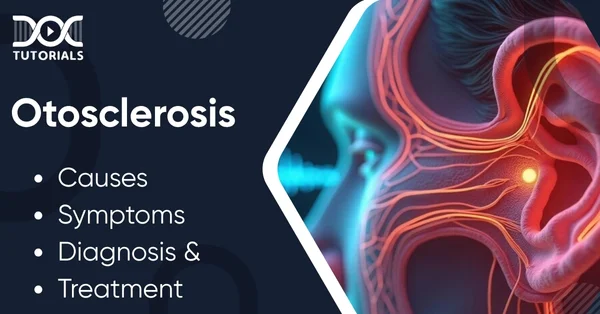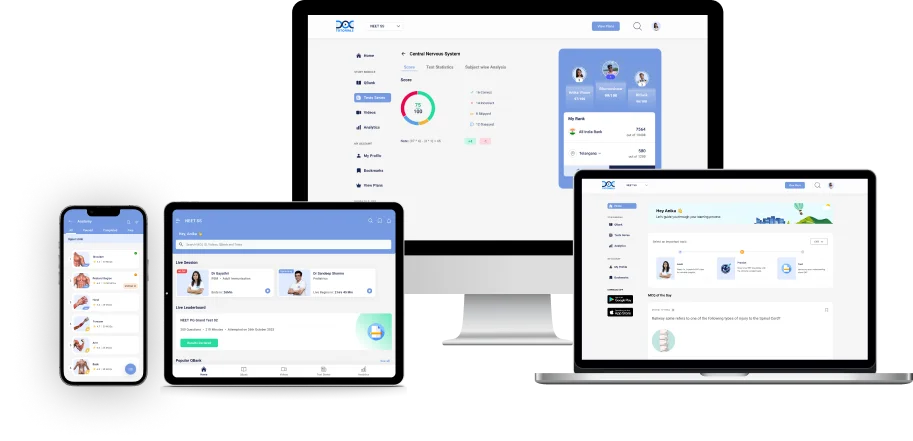Otosclerosis: Types, Causes, Symptoms, Diagnosis, and Treatment

Otosclerosis is caused by an abnormal growth of bone in the middle ear and occasionally in the inner ear. Normally, the bones in the body continuously renew themselves, but in otosclerosis, this process does not function properly.
Sound is transmitted through the ear, and when abnormal bone growth develops inside, it becomes difficult for the air to pass. Otosclerosis can cause mild to severe hearing impairment. It usually affects both ears, but one ear is often worse.
Understanding otosclerosis, its causes, symptoms, types, diagnosis, and treatment is important for medical students, especially those preparing for NEET PG and other competitive exams. In this article, we will cover all the essential aspects of otosclerosis in detail.
Keep reading for a better insight.
What are the Types of Otosclerosis?
Listed below are the ostosclerosis types in detail:
1. Stapedial Otosclerosis
The most common type is stapedial otosclerosis, which usually starts near the fistula ante fenestrae. It mainly causes conductive hearing loss, which means sound can’t be appropriately transmitted through the middle ear.
2. Cochlear Otosclerosis
Cochlear otosclerosis often affects the round window area in the inner ear. It leads to sensorineural hearing loss, meaning there’s damage to the inner ear or hearing nerve. It may also cause tinnitus (ringing in the ears)
3. Histological Otosclerosis
Histological osteosclerosis is only found under a microscope during medical studies. Since people usually don’t have symptoms, it often goes unnoticed in daily life.
What Causes Otosclerosis?
Inside the human ear are three tiny bones (ossicles) that help transfer sound to the inner ear. When sound waves enter the ear, these bones vibrate, allowing sound to move forward.
In otosclerosis, abnormal bone growth causes the stapes bone to become fixed or stuck. This prevents the stapes from vibrating properly, which blocks sound transmission and leads to hearing loss.
What are the Risk Factors of Otosclerosis?
Several factors can increase the risk of otosclerosis, such as:
- Family History: The risk of developing otosclerosis could be hereditary.
- Sex: Females are more likely to be affected by this condition.
- Race: Otosclerosis is more prevalent in white people.
- Pregnancy: Hormonal changes during pregnancy might trigger the condition in people who are already at risk.
- Osteogenesis Imperfecta: A condition known as brittle bone disease may also increase the risk.
What are the Symptoms of Otosclerosis?
Listed below are otosclerosis symptoms that one must be aware of:
- Gradual hearing loss often makes it difficult to hear soft or low-pitched sounds. It usually affects both ears, but sometimes only one.
- Ringing in the ears (tinnitus)
- Dizziness or balance problems
- Speaking more softly, since the voice may sound louder in the head
What is the Diagnosis of Otosclerosis?
If the doctor suspects otosclerosis, they’ll refer the patient to an ear, nose, and throat (ENT) specialist. The specialist may do the following diagnostic tests:
- Perform a hearing test (audiogram) to measure hearing levels.
- Use a tympanogram to check how well the eardrum moves.
- Order a CT (computed tomography) scan to get a clear view of the bones inside the ear.
Diagnostic Tests for Stapedial Otosclerosis
Listed below are the diagnostic tests for stapedial otosclerosis, and their observations:
| Test | Result/Observation |
| Rinne Test | Negative (bone conduction is better than air) |
| Weber Test | Sound lateralizes to the affected ear |
| Absolute Bone Conduction | Normal |
| Gelle’s Test | Negative (no change in bone conduction) |
| Tympanometry | Type A curve (suggests stiff middle ear) |
| Stapedial Reflex | Absent |
| Pure Tone Audiometry | Shows Carhart’s notch (dip at 2000 Hz) |
Diagnostic Tests for Cochlear Otosclerosis
Listed below are the diagnostic tests for cochlear otosclerosis, and their observations:
| Test | Result/Observation |
| Rinne Test | Positive (air conduction better than bone) |
| Weber Test | Sound lateralizes to the normal ear |
| Absolute Bone Conduction | Reduced/Shortened |
| Pure Tone Audiometry | May also show a Carhart’s notch |
What is the Treatment for Otosclerosis?
Treatment depends on how severe the condition is and where the bone growth is developing. Standard otosclerosis treatment options include:
- Hearing Aids: These devices make surrounding sounds louder so you can hear better. They don’t stop the condition from worsening, but they can help manage hearing loss.
- Stapedectomy (Surgery): In this surgery, the doctor replaces the stapes bone with a small artificial part, allowing sound to pass through again. If both ears are affected, the surgeries are usually performed several months apart to allow recovery.
- Cochlear Implants: If the condition affects the inner ear (called cochlear otosclerosis), a cochlear implant may help. This device creates a new path for sound to reach your brain, bypassing damaged inner ear structures.
What are the Complications of Otosclerosis?
Otosclerosis also have several complications, which include:
- Perilymph Fistula: This can occur if the oval window tears, causing inner ear fluid to leak.
- Recurrence of Hearing Loss: This may happen if the prosthesis becomes displaced or if new bone forms after a stapedotomy.
- Incus Necrosis: If the piston is too tightly fixed, it can reduce blood supply to the incus, leading to bone tissue damage.
- Facial Nerve Palsy: The facial nerve runs close to the footplate, so there’s a risk of nerve injury during surgery, which may cause temporary or permanent facial weakness.
FAQ about Otosclerosis
- What happens if otosclerosis is not treated?
If left untreated, otosclerosis can gradually worsen and may eventually affect the inner ear, leading to cochlear otosclerosis.
- Can otosclerosis be prevented?
Otosclerosis can’t be prevented, as it’s mostly linked to genetics rather than external factors like noise exposure.
- How is otospongiosis different from otosclerosis?
Otospongiosis is the early stage, where soft bone forms. As the bone hardens over time, it gradually develops into otosclerosis.
Conclusion
It is essential to clearly understand the causes, types, symptoms, diagnosis, and treatment options for otosclerosis. Recognising early signs and knowing available management strategies can help improve patient outcomes and preserve hearing health.
DocTutorials provides comprehensive NEET PG preparation courses, including topic-wise courses, question banks, expert video lectures, mock tests, and personalised mentorship.
Join DocTutorials to strengthen your medical knowledge and succeed in your medical journey!
Latest Blogs
-

NEET PG Exam 2025- Date, Pattern, Marking Scheme, Subject Wise Weightage, and Exam Mode
NEET PG Exam 2025 is the ultimate gateway for medical graduates aspiring to pursue postgraduate courses in medicine, including MD,…
-

INI CET Exam 2025: Your Roadmap to Success – Key Topics, Strategies, and Lessons from Last Year’s Papers
The INI CET exam is more than just a test; it’s a significant milestone for many medical students aiming to…
-

INI CET Exam Success: Previous Year Question Papers & Ultimate Guide – INI CET PYQ
One can feel overwhelmed while preparing for the INI CET (Institute of National Importance Combined Entrance Test). A vast syllabus,…




